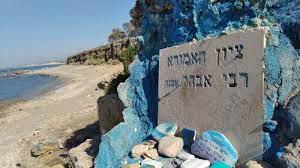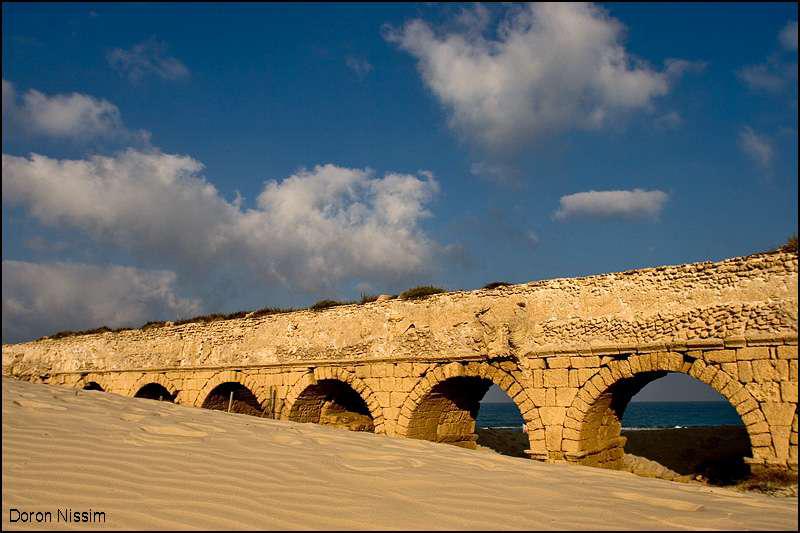
נקודת סיום: פארק נחל חדרה
סך הכל: 22 ק"מ
תיאור המקטע
המקטע מתחיל בירידה מגני הנדיב לכיוון דרום, בחורבת עקב מומלץ לעצור על סף המצוק ולהביט בנוף הנשקף (ביום טוב ניתן לראות מחיפה ועד חדרה) השביל ממשיך ועובר מתחת לגשר של כביש 4, מדרום לפנייה למושב בית חנניה.
קטע יפה במיוחד של אמת המים נמצא בצמוד וממערב לשער הכניסה למושב. כ-100 מ' מערבה מהשער תראו את שתי אמות המים , האמה הביאה מים מעינות שוני והיא נבנתה על ידי הלגיון העשירי בימי אנדריאנוס (סמל הליגון מוטבע באמה במספר מקומות) השביל ממשיך לאורך הקטע הדרומי, מגיע לכביש 2, שם נכנס בכביש מתחת לגשר לג'סר א-זרקא.
בתקופה הרומית האמה המשיכה ישר אל הרכס עליו יושב כיום הכפר ג'סר א-זרקא, וחצתה אותו בניקבת מים גדולה וארוכה (כ- 400 מטרים), השנייה באורכה אחרי ניקבת השילוח. לצערנו, ניקבה מרשימה זו סגורה לקהל.
נחצה את הכפר ג'סר א-זרקא דרך הכביש הראשי שלו, עד לכפר הדייגים. בעבר התפרנס הכפר מביצת כבארה- קליעת מחצלות מצמחי הגומא לצד דיג. עד לשנות השמונים לא נישאו בני ובנות הכפר עם צעירים מחוץ לכפר בשל דימוי שלילי בקרב האוכלוסייה הערבית מה שגרם לריבוי של מחלות תורשתיות בקרב התושבים. ז'סר א-זרקא הוא אחד הישובים העניים בארץ והוא שוכן בצמידות לקיסריה שהיא אחד הישובים העשירים בארץ. בשנת 2002 נבנתה סוללת עפר בין ג'סר לבין קיסריה. בעבר היו השביליסטים משתדלים לעבור בכפר במהירות, אבל בשנים האחרונות ישנו פיתוח גדול במקום, בין השאר נחנכה במקום תחנת משטרה, הגשר על נחל תנינים שופץ ובמרכז הכפר הוקמה אכסניה לשביליסטים וכיום מומלץ לשביליסטים ללכת בכפר במתינות ולהנות מהמקום המיוחד ואף להשאר וללון בגסטהאוס שבכפר.
אחרי שתסיימו ללכת בכפר, קצת לפני החוף, השביל הולך לאורך הגדה הדרומית של שפך נחל תנינים שם ניתן לראות את הגשר המשופץ- הגשר שעל שמו קרוי הכפר- הגשר נבנה לכבוד מסעו של הקיסר הגרמני וילהלם השני (אותו הקיסר שהרצל נסע לארץ ישראל כדי לפגוש אותו), והוא שנתן לנחל את שמו ומכאן גם שם הכפר. "ג'סר" פירוש "גשר" - ו"א-זרקא"- פירושו "הכחול" זאת אומרת "הגשר על הנחל הכחול". זה הנחל הנקי האחרון בנחלי מישור החוף. בעברית נחל א-זרקא נקרא בשם נחל תנינים. במאה ה-19 עדיין חיו בו תנינים, אך כיום אין חשש- פוחלץ התנין האחרון שוכן באוסף הזואולוגי של האב שמיץ בירושלים.
מכאן יש הליכה נעימה וקלה לאורך החוף, דרך כפר הדייגים הציורי של ג'סר עד חוף האקוודוקט של קיסריה, כ- 2.5 ק"מ (חוף הקשתות).
מחוף הקשתות יוצאת טיילת באורך של 750 מטרים עד לבית הכנסת העתיק של קיסריה, בית הכנסת, החפיר והחומות נמצאים מחוץ לאתר הסגור וניתן להגיע אליו ללא תשלום דמי כניסה לאתר.
קיסריה הוקמה כמעגן פיניקי בתקופה הפרסית (המאה הרביעית לפני הספירה) בשם "סטראטון" (שיבוש של השם עתשתורת), אלכסנדר ינאי כבש את העיר וסיפח אותה לממלכה החשמונאית, פומפיוס הרומאי נתן את העיר במתנה להורדוס וזה האחרון בנה בה עיר נמל מודרנית וקרה לה בשם "קיסריה" על שמו של הקיסר. קיסריה של הורדוס נבנתה כעיר הלניסטית מודרנית והכילה בתי מרחץ, תאטראות, בתי שעשועים ונמל ענקי. העיר היתה נכרית ברובה אבל התגוררו בה גם יהודים. בשנת 66 לספירה פרץ ה"מרד הגדול" בעקבות שרשרת של אירועי דמים בין יהודים לנכרים סביב בית הכנסת בקיסריה. בעקבות כך כונה בית הכנסת בשם "כניסתה דמרדותא". בימי מרד בר כוכבא שימשה קיסריה כבסיס האם של האימפריה הרומית ושם הוצאו להורג חלק מעשרת הרוגי מלכות.
לאחר התנצרות הממלכה הרומית הפכה קיסריה למרכז נוצרי חשוב (בה גר בין היתר אב הכנסיה אוסביוס) ובמקום ישבו גם חלק מאמוראי ארץ ישראל כותבי התלמוד הירושלמי וכאן נערכה מסכת נזיקין של התלמוד הירושלמי. בתקופת הצלבנים החליפה קיסריה ידיים בין הצלבנים למוסלמים ובסופו של דבר חרבה במאה ה-13 על ידי הקיסר הממלוכי ביבארס שהחריב את כל ערי החוף.
במאה ה-19 התיישבו בתוך אתר העתיקות מוסלמים בוסניים (שברחו מבוסניה שעברה לידיים נוצריות של האימפריה האוסטרו-הונגרית), הבוסנים התיישבו בקיסריה ובכפר יאנון ליד שכם הם לא התחתנו עם האוכלוסיה המקומית והעדיפו לשלוח את ילדיהם לבתי ספר יהודים בזיכרון יעקב. הבוסנים גורשו מאתר העתיקות של קיסריה על ידי לוחמי ההגנה בקרבות מלחמת השחרור.
כיום ישנו במקום גן לאומי מרשים שהנו אחד מהגנים הלאומים המתוירים ביותר בישראל. זמני הכניסה: בימים א' - ה' ושבת: 17:00 - 08:00 בימי שישי וערבי חג: 16:00 - 08:00
לאחר שעוזבים את קיסריה העתיקה, השביל ממשיך דרומה עוקף ממזרח את גן לאומי קיסריה (כך שהשביליסטים לא צריכים לשלם לכניסה לפארק) השביל עוקף ממזרח את קיבוץ שדות ים. בתוך קיבוץ שדות ים נמצא מוזאון "בית חנה סנש" שחודש בשנת 2021 לכבוד מאה שנה להולדת חנה סנש. במקום גם נמצאים ממצאים יהודיים מבית הכנסת העתיק בקיסריה. ממשיכים בשביל ועוקפים את תחנת הכוח "אורות רבין" של חברת חשמל חולפים ליד פסל מתכת של האומן אורי ליפשיץ "לא תרצח- הצדעה ליצחק רבין" עד שמגיעים לפארק נחל חדרה. חוף שנחל עזבו. כאן מסתיים המקטע שלנו.
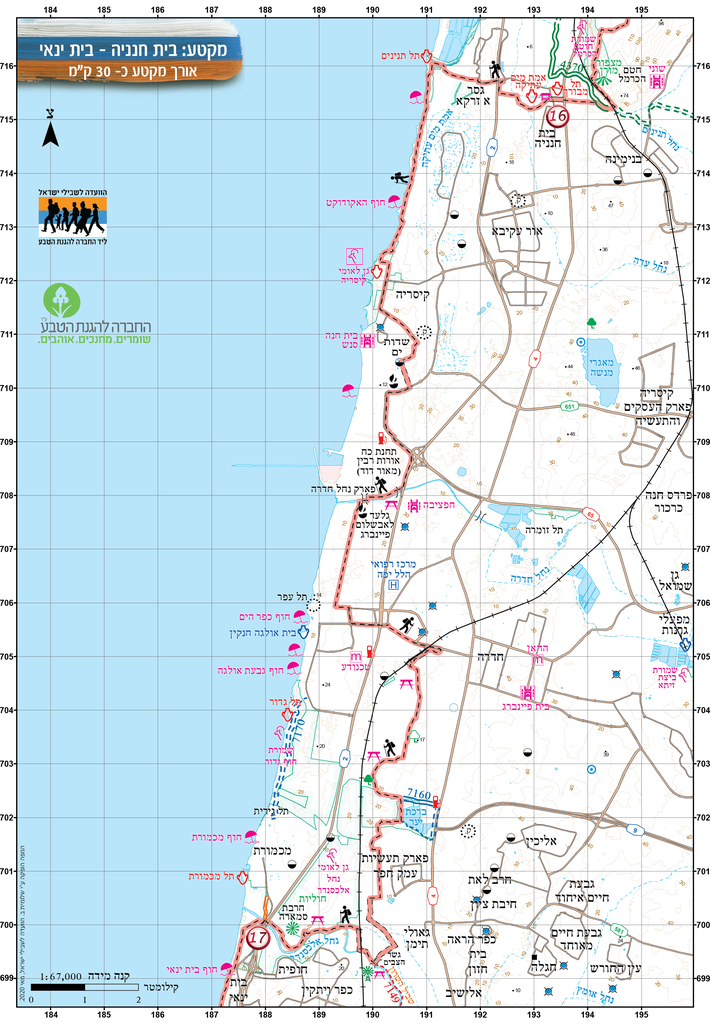
חוף התקווה - הליכה על החוף אל מול המרחב האין-סופי של הים
(ניתן לדלג על לימוד זה ולעבור ישר ללימוד המרכזי בנושא "הליכה לקיסריה")
מילים ולחן: נעמי שמר
הרוח והחושך והמים
זוכרים מליל אתמול את צעדך
הקצף שמחה את עקבותייך
יודע שהיית כאן לבדך
אני כעיוור אחרייך הולך
רוח בחושך נושקת לפני המים
שוב לא יאיר אלי בחוף בעברך
צחור החבצלת בשחור שערך
המים והרוח והחושך
אמרו לי שעברת כאן יחפה
מדוע לא הייתי כאן ללחוש לך
חכי לי נעצבת ויפה
אני כעיוור אחרייך הולך
רוח בחושך נושקת לפני המים
שוב לא יאיר אלי בחוף בעברך
צחור החבצלת בשחור שערך
החושך והמים והרוח
עונים לי בחידה שאין לה סוף
הו מה הם הקולות אשר קראו לך
בלילה בלי ירח אל החוף
אני כעיוור אחרייך הולך
רוח בחושך נושקת לפני המים
שוב לא יאיר אלי בחוף בעברך
צחור החבצלת בשחור שערך
אָמַר רֵישׁ לָקִישׁ מַאי דִּכְתִיב אֲנִי אֵל שַׁדַּי אֲנִי הוּא שֶׁאָמַרְתִּי לָעוֹלָם דַּי אָמַר רֵישׁ לָקִישׁ בְּשָׁעָה שֶׁבָּרָא הַקָּדוֹשׁ בָּרוּךְ הוּא אֶת הַיָּם הָיָה מַרְחִיב וְהוֹלֵךְ עַד שֶׁגָּעַר בּוֹ הַקָּדוֹשׁ בָּרוּךְ הוּא וְיִבְּשׁוֹ שֶׁנֶּאֱמַר גּוֹעֵר בַּיָּם וַיַּבְּשֵׁהוּ וְכׇל הַנְּהָרוֹת הֶחֱרִיב
עימדו על החוף והתבוננו בעוצמה הכבירה של הים ,
חישבו על הפסוק בתהילים (פרק צ"ד) "מקולות מים רבים אדירים משברי ים"
התבוננו בגלי הים שמנסים "לבלוע" את היבשה ונסו להבין את המקור הנפשי של המיתוסים ושל המדרשים השונים.
הפסיכולוג קרל יוסטב יונג חיבר את תאוריית "פסיכולוגית המעמקים" על בסיס רעיון התהום (והמקבילה שלו "השאול") שבו התת מודע מאיים בכל רגע "להציף" את האדם. בבריאת העולם האל "הנמיך" את התהום, ביטל את התוהו וכלא אותה במעמקים ובכך אפשר ליבשה לנצח את הים, אבל התוהו ובוהו עדיין מאיים בכל רגע להתפרץ לבלוע אל העולם.
אבל לצד הים כמקום מאיים שבו שוכנות מפלצות קדמוניות (לויתן, תנינים ועוד) .
האין סופיות של הים שממלא את כל האופק הוא גם מקור להשראה.
נסיים בשיר של המשוררת זלדה שעומדת אל מול הים ומעוניינת להכניס לתוך החיים הארציים את הרוח הגדולה שבאה מן הים (הבאנו כאן רק חלק מהשיר)
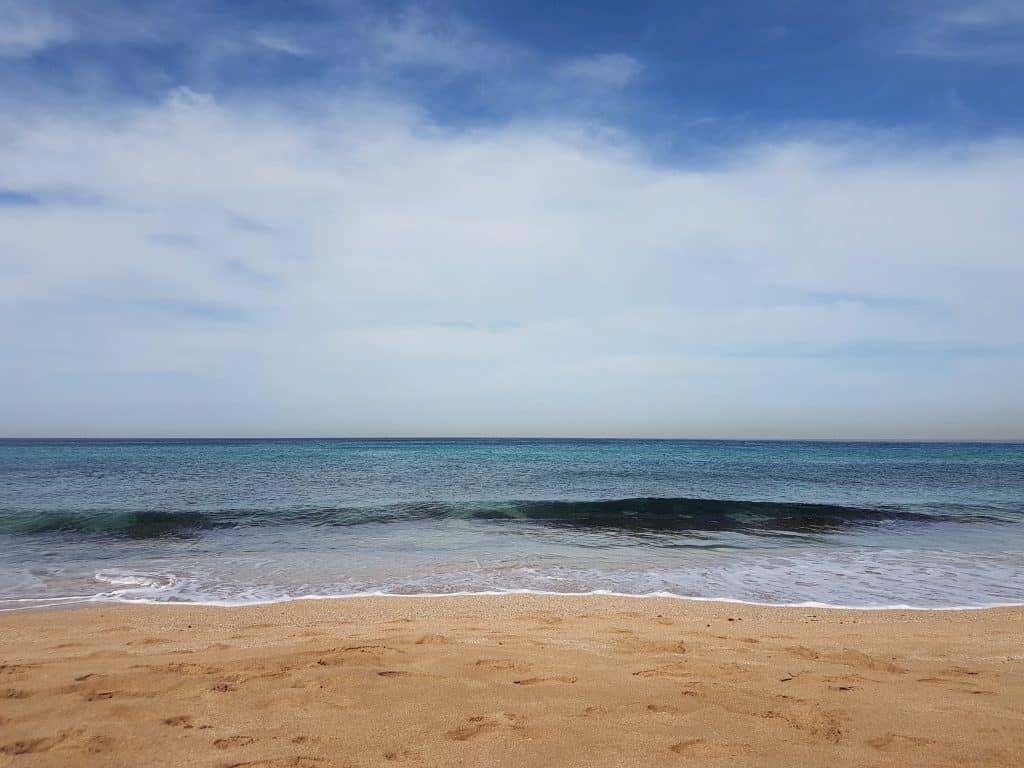
זלדה
...כְּלוּם שָׁכָחְתִּי
מַה מְּקַנְאָה הָיִיתִי בְּיוֹרְדֵי-הַיָּם
וּבְאֵלֶּה שֶׁבֵּיתָם עַל חוֹף הָאוֹקְיָנוֹס.
כִּי אָמַרְתִּי בְחָפְזִי
הָרוּחַ הָרַעֲנַנָּה שֶׁל הַיָּם
חוֹדֶרֶת לְחַיֵּיהֶם,
הָרוּחַ הָרַעֲנַנָּה שֶׁל הַיָּם
חוֹדֶרֶת לְמַחְשְׁבוֹתֵיהֶם, הָרוּחַ הָרַעֲנַנָּה
חוֹדֶרֶת לְיַחֲסֵיהֶם עִם שְׁכֵנֵיהֶם
וּלְיַחֲסֵיהֶם עִם בְּנֵי מִשְׁפַּחְתָּם.
הִיא מְנַצְנֶצֶת בְּעֵינֵיהֶם
וּמְשַׂחֶקֶת בִּתְנוּעוֹתֵיהֶם.
כִּי אָמַרְתִּי בְחָפְזִי
אַמַּת-הַמִּדָּה לַמעֲשֵׂיהֶם
הִיא אַמַּת-הַמִּדָּה שֶׁל הַיָּם וְתִפְאַרְתּוֹ
וְלֹא זוֹ שֶׁל הָרְחוֹב הָאֱנוֹשִי
וְלֹא זוֹ שֶׁל הַסִּמְטָה הָאֱנוֹשִית.
כִּי אָמַרְתִּי בְחָפְזִי
רוֹאִים הֵם עַיִן בְּעַיִן
אֶת מַעֲשֵׂי אֱלֹהִים
וְחָשִׁים בִּמְצִיאוּתוֹ
בְּלִי הַמְּחִצּוֹת שֶׁלָּנוּ,
בְּלִי הֶסַּח-הַדַּעַת שֶׁלָּנוּ.
בָּכִיתִי תָּמִיד
שֶׁכְּלוּאָה הִנְנִי
בֵּין הַכְּתָלִים שֶׁל הַבַּיִת,
בֵּין כָּתְלִי הָרְחוֹב
בֵּין הַכְּתָלִים שֶׁל הָעִיר,
בֵּין הַכְּתָלִים
שֶׁל הֶהָרִים.
בַּלַּיְלָה הַהוּא כּשֶׁיָּשַׁבְתִּי לְבַדִּי
בֶּחָצֵר הַדּוֹמֶמֶת
גִּלִּיתִי פִּתְאֹם
שָׁאַף בֵּיתִי בָּנוּי עַל הַחוֹף,
שֶׁחַיָּה אֲנִי עַל שְׂפַת הַיָּרֵחַ
וְהַמַּזָּלוֹת,
עַל שְׂפַת הַזְּרִיחוֹת וְהַשּׁקִיעוֹת.
למה לדעתכם זלדה קינאה ביורדי הים? מה יש להם שאין לה בביתה שבירושלים?
מה גילתה זלדה בסוף השיר? מה הכוונה בכך שגם הבית שלה בירושלים נמצא על החוף?
עם מי אתם יותר מזדהים- עם התיאור של ריש לקיש (ושל הפסיכולוג יונג) על הים כמקום מאיים או התיאור של זלדה על הים כמקור להשראה?
איזה השראה אתם מקבלים שאתם מתבוננים בים?
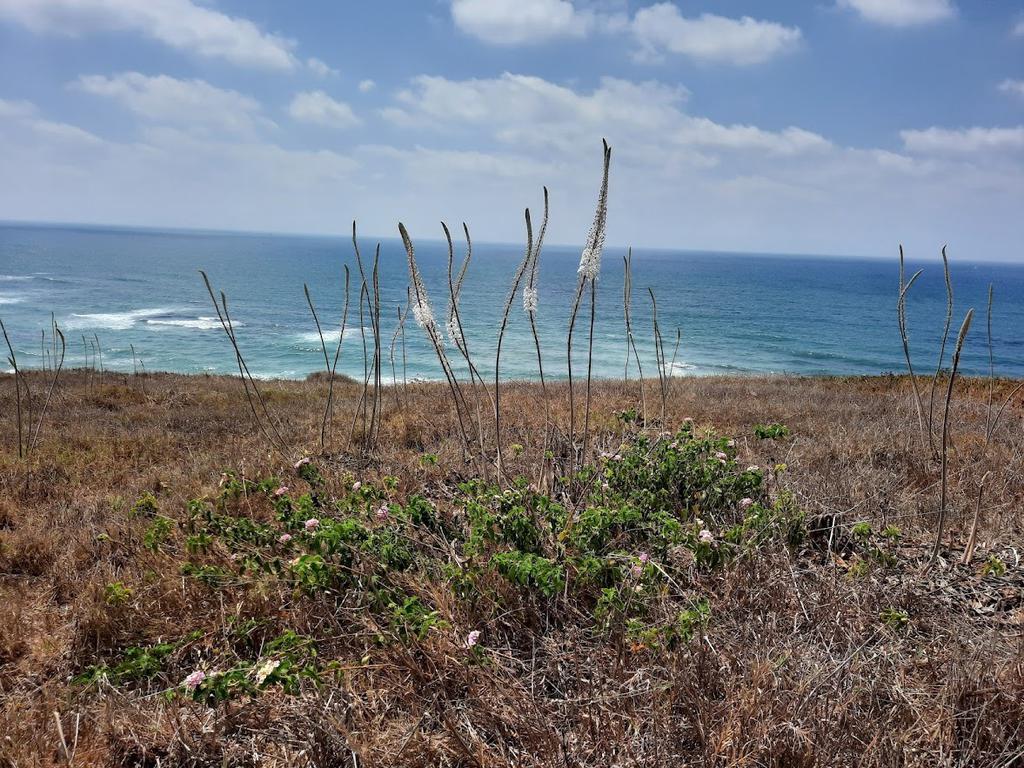
חצבים על חוף הים. צילום: זיו רפפורט
מרבי עקיבא ועד חנה סנש
לפי המסורת היהודית רבי עקיבא נרצח באכזריות ובשרו נסרק במסרקות של ברזל, באומרו :"שמע ישראל ה' אלוקינו ה' אחד". מאז רבי עקיבא הפכה קריאת "שמע ישראל" לקריאת האמונה של המתים על קידוש השם. לזכרו של רבי עקיבא הוקמה ליד עתיקות קיסריה העיר "אור עקיבא" (הסיבה למילה "אור" היא הפסוק שפותח את תפילות יום הכיפורים: "אור זרוע לצדיק ולישרי לב שמחה" -סופי האותיות עקיבה כפי שהוא נקרא בתלמוד הירושלמי)
1808 שנים אחרי פטירתו של רבי עקיבא הולכת חנה סנש על חוף הים של קיסריה - היא יוצאת מהבית שלה בקיבוץ שדות ים והולכת בין שרידי העבר וכותבת ביומנה שיר בשם "עליה לקיסריה" : אך בבואנו אל עיר החרבות// חרש נלחש מילים אחדות// היננו, חזרנו// וחרש תשיב דממת אבנים:// חיכינו לכם אלפיים שנים" (השיר נכתב ב: 27-10-1941 ותודה למדריך הטיולים מאיר שוורץ על ההפניה)
אחרי שנתיים חנה סנש, צועדת שוב בחוף הים ומתפללת את תפילת האדם:
"אלי שלא יגמר לעולם, החוף והים, רשרוש של המים, ברק השמים האמון באדם".
דף הלימוד של היום יעסוק בשתי דמויות אלו ובהליכה האחרונה לקיסריה
נקל להבין שרעיון זה לא נולד בן-לילה. לפני שלוש שנים, כאשר שמעתי בפעם הראשונה על הציונות, התנגדתי לה בכל כוחי. אבל המאורעות והתקופה בה אנו חיים קירבו אותי בינתיים לרעיון זה. כמה שמחה אני שהגעתי אליו. עכשיו חשה אני קרקע מתחת לרגליי ורואה לפניי מטרה אשר כדאי לעמול למענה. ... השתניתי לגמרי, וכה טוב לי ככה.
האמונה נחוצה מאוד לאדם, וחשוב שתהיה לו הרגשה שחייו אינם מיותרים, אינם חולפים לריק, שהוא ממלא תפקיד. את כל אלה נותנת לי הציונות. הכרתי הברורה היא כי זהו הפתרון היחיד של הבעיה היהודית, וכי המפעל הנהדר בארץ-ישראל הולך ומוקם על יסוד איתן. אני יודעת שיהיה קשה, אבל הכול כדאי.
וברעננות הבוקר הנפלא הבינותי למה קיבל משה את התורה על ההר.
רק בהרים אפשר לקבל פקודה מלמעלה, כשרואים כמה קטון האדם
ובכל זאת מרגישים את הביטחון בקרבת האלוהים. על ההר מתרחב
האופק בכל המובנים ומבינים את סדר העולם. בהרים יכולים להאמין
וצריך להאמין. בהרים עולה השאלה מאליה: את מי אשלח? –
שלח אותי! לשרת את הטוב והיפה. – האוּכל? (25 ביולי 1940)
למה חנה סנש בחרה לצאת למעבר לים?
התשובה נמצאת באחד משיריה המפורסמים:
קוֹל קָרָא והָלַכְתִי,
הָלַכְתִי כִּי קָרָא הַקּוֹל...
השיר קול קורא וגם קטעי היומן "מתכתבים" עם פסוקי ההקדשה של ישעיהו הנביא:
וָאֶשְׁמַ֞ע אֶת־ק֤וֹל אֲדֹנָי֙ אֹמֵ֔ר אֶת־מִ֥י אֶשְׁלַ֖ח וּמִ֣י יֵֽלֶךְ־לָ֑נוּ
וָאֹמַ֖ר הִנְנִ֥י שְׁלָחֵֽנִי׃
(3) And one would call to the other,
“Holy, holy, holy!
The LORD of Hosts!
His presence fills all the earth!”
(4) The doorposts would shake at the sound of the one who called, and the House kept filling with smoke. (5) I cried,
“Woe is me; I am lost!
For I am a man of unclean lips-b
And I live among a people
Of unclean lips;
Yet my own eyes have beheld
The King LORD of Hosts.”
(6) Then one of the seraphs flew over to me with a live coal, which he had taken from the altar with a pair of tongs. (7) He touched it to my lips and declared,
“Now that this has touched your lips,
Your guilt shall depart
And your sin be purged away.”
(8) Then I heard the voice of my Lord saying, “Whom shall I send? Who will go for us?” And I said, “Here am I; send me.” (9) And He said, “Go, say to that people:
‘Hear, indeed, but do not understand;
See, indeed, but do not grasp.’ (10) Dull that people’s mind,
Stop its ears,
And seal its eyes—
Lest, seeing with its eyes
And hearing with its ears,
It also grasp with its mind,
And repent and save itself.”
(11) I asked, “How long, my Lord?” And He replied:
“Till towns lie waste without inhabitants
And houses without people,
And the ground lies waste and desolate— (12) For the LORD will banish the population—
And deserted sites are many
In the midst of the land. (13) “But while a tenth part yet remains in it, it shall repent. It shall be ravaged like the terebinth and the oak, of which stumps are left even when they are felled: its stump shall be a holy seed.”
איזה קול לדעתכם חנה סנש שמעה?
דוד בן גוריון, בספרו עיונים בתנ"ך (אגב דיון על סוגית "קדמות העברים" בחוג התנ"ך בבית ראש הממשלה בירושלים) , מפרש את הקריאה "לך לך מארצך" בכך שאברהם שמע את הקול הפנימי שקורא לו לעלות לארץ ישראל. בן גוריון פונה לחבריו בחוג התנ"ך, שהיו כולם פרופסורים למקרא שנולדו בחו"ל ועלו לארץ ושאל אותם: "האם לא כולכם שמעתם את הקול הפנימי ובעקבותיו עליתם לארץ?"
האם אתם שמעתם אי פעם קול פנימי?
מה לדתכם הקשר בין הקול הקורא לבין ערך השליחות?

אַשְׁרֵי הַלֶּהָבָה שֶׁבָּעֲרָה בְּסִתְרֵי לְבָבוֹת.
אַשְׁרֵי הַלְבָבוֹת שֶׁיָדְעוּ לַחְדֹל בְּכָבוֹד.
אַשְׁרֵי הַגַּפְרוּר שֶׁנִּשְׂרַף וְהִצִּית לֶהָבוֹת.
"אימי היקרה והאהובה, אין לי מילים, רק זאת אוכל להגיד לך: מיליוני תודות. סלחי לי אם אפשר. את לבדך תביני מדוע אין צורך במילים. באהבה אין קץ, בתך"
אלמונים הביאוה לקבר ישראל, ב"חלקת המרטירים", בבית העלמין היהודי בבודפשט
בשנת 1950 הובא ארונה של חנה סנש מבודפשט לווינה, שם קיבלה אותו משלחת רשמית של מדינת ישראל , המונים חלקו לחנה סנש כבוד במסע ההלוויה שעבר בקיבוץ שדות ים שחנה סנש הייתה מראשוניו. שם הוצב ארונה עם משמר כבוד ב"בית חנה סנש" והסתיים בקבורתה בהר הרצל בירושלים בחלקת "צנחני הישוב". במחברת של חנה סנש שנמצאה לאחר מותה כתבה חנה סנש, בין היתר, גם את השורה הבאה: "זיכרון נשיקת הנצח יבער על שפתי"
השיר מכיל סך הכול 14 מילים ואורכו 6 שורות בלבד. הוא כתוב כתפילה לאל, שבה מבקשת ממנו המשוררת לשמור על "החול והים", "רשרוש של המים", "ברק השמים" ועל "תפילת האדם". או לפי הגירסא הראשונה של השיר "האמון באדם".
יש כאן חתך רוחבי של הנוף: בתחתית נמצא החול, מעליו הים, ומעליהם הברקים שבשמים ומעל השמים האמון והתפילה.
למרות שחנה סנש מזוהה אצלנו עם ערכי הציונות והגבורה, השיר הוא שיר אוניברסאלי שעוסק באדם באשר הוא אדם.
השיר נקרא "הליכה לקיסריה" ובו חנה סנש כותבת מתוך החוויה של ההליכה על חוף הים שעליו אתם הולכים עכשיו. ההליכה על חוף הים השדות ים לקיסריה היתה חלק משגרת היום של חנה סנש.
בתודעה הישראלית השיר מתחבר עם הליכתה האחרונה של חנה סנש , הליכה לכיוון הים שממנו היא המשיכה מעבר לים אל לצנוח מעבר לקווי האויב. אנחנו ממליצים לכם להאזין לשיר ולאחר מכן לחשוב על השאלות:
אֵלִי, אֵלִי
שֶׁלֹּא יִגָּמֵר לְעוֹלָם
הַחוֹל וְהַיָּם,
רִשְׁרוּשׁ שֶׁל הַמַּיִם,
בְּרַק הַשָּׁמַיִם,
תְּפִלַּת הָאָדָם.
1. מה הרגשתם במהלך השמיעה של השיר?
על הלחן כתב מלחין השיר דוד זהבי כך : "אחד השירים היפים ביותר שהלחנתי בימי חיי הוא השיר "הליכה לקיסריה", ואודה על האמת כי בשעה שהלחנתי את השיר... זלגו עיניי דמעות"
2. מה לדעתכם הקשר בין חוף הים לבין תפילת האדם?
3. מה לדעתכם ההבדל בין שני הביצועים השונים של השיר? איזה פירוש נותן כל ביצוע למושג "תפילת האדם"?
3. מה אתם לוקחים אתכם מהסיפור של חנה סנש?
רחל עודדה את בעלה ללמוד תורה ובגיל 40 יצא עקיבא ללמוד קרא וכתוב עם הילדים. עקיבא הלך ללמוד בבית המדרש במשך שתים-עשרה שנה מתוך אהבה גדולה לתורה בעוד רחל וילדיו חיים חיי עוני ומחסור. למרות כל זאת כשחזר רבי עקיבא לביתו, שמע את אשתו אומרת: "אם מציית הוא לי, ישב שתים עשרה שנים נוספות". לאחר ששמע דברים אלה, הבין שאשתו נותנת לו רשות להמשיך בלימוד ושב לבית המדרש לשתים-עשרה שנים נוספות שבהן הוסיף דעת ותלמידים. כשחזר לבסוף לביתו, והוא כבר רב מפורסם שתלמידיו רבים, יצאו לקראתו כל אנשי העיר, וגם רחל אשתו ביניהם. תלמידיו, שלא הכירו אותה ניסו לסלק אותה, אך הוא עצר בעדם ואמר להם: "שלי ושלכם - שלה הוא!" (כלומר כל הלימוד שלי, שבזכותו לימדתי אתכם - בזכותה הוא נעשה). מסופר שגם כלבא שבוע בעצמו יצא לקבל את פני הרב הגדול, ולא ידע שהוא חתנו שהתכחש לו ובגללו הדיר את ביתו מהצוואה. משהכיר בטעותו ביקש מרבי עקיבא להתיר את נדרו והלה נענה לו.
את סיפור גדולתו של רבי עקיבא ניתן ללמוד או מהמדרשים השונים וגם משירה של דליה רביקוביץ "רבי עקיבא"
מילים: דליה רביקוביץ'
לחן: מוני אמריליו
רבי עקיבא איש צנוע
היה רועה בין הרועים
את עדרי כלבא שבוע
עד שנתו הארבעים
ראתה אותו רחל
בתו של כלבא שבוע
ראתה אותו רחל
והוא מעולה וצנוע
אמרה לו רחל בחשאי
קח אותי לאישה
בתנאי שתקדיש זמנך
ללימוד התורה הקדושה
רבי עקיבא....
והיו גרים במתבן
בגורן אחד לא ידוע
זוג אחד פשוט ללא שם
שהיה מעולה וצנוע
ובבוקר היה מלקט
התבן מתוך שערה
אמרה לו רחל - תהיה אהובי
גדול בתורה
רבי עקיבא....
קם הרב ונסע לבירה
לגמוע תורה כמבוע
ושם בגורן נשארה
ביתו של כלבא שבוע
ומקץ עשרים שנה
כאשר הלבין שערה
שב בעלה לביתו
והוא גדול בתורה
רבי עקיבא...
חזר הרב לביתו
וכל נפשו געגוע
חזר הרב אל אשתו
בתו של כלבא שבוע
הדפוה משם תלמידיו
אמרו לה סורי אשה
אמר הרב - הניחוה
כי היא תורתי הקדושה
מתוך אהבה גדולה לעם ישראל ולארץ ישראל, רבי עקיבא תמך במרד כוכבא והיה נחשב "לנושא כליו" של מנהיג המרד בר כוסבא. בעקבות המרד, רבי עקיבא נלכד על יד הרומאים ונלקח לעיר הרומאית קיסריה. וכך מתארת הגמרא את רגעיו האחרונים של רבי עקיבא
לֹא הָיוּ יָמִים מוּעָטִים, עַד שֶׁתְּפָסוּהוּ לְרַבִּי עֲקִיבָא וַחֲבָשׁוּהוּ בְּבֵית הָאֲסוּרִים...
בְּשָׁעָה שֶׁהוֹצִיאוּ אֶת רַבִּי עֲקִיבָא לַהֲרִיגָה זְמַן קְרִיאַת שְׁמַע הָיָה, וְהָיוּ סוֹרְקִים אֶת בְּשָׂרוֹ בְּמַסְרְקוֹת שֶׁל בַּרְזֶל, וְהָיָה מְקַבֵּל עָלָיו עוֹל מַלְכוּת שָׁמַיִם.
אָמְרוּ לוֹ תַּלְמִידָיו: רַבֵּינוּ, עַד כָּאן?! אָמַר לָהֶם: כׇּל יָמַי הָיִיתִי מִצְטַעֵר עַל פָּסוּק זֶה ״בְּכָל נַפְשְׁךָ״ אֲפִילּוּ נוֹטֵל אֶת נִשְׁמָתְךָ. אָמַרְתִּי: מָתַי יָבֹא לְיָדִי וַאֲקַיְּימֶנּוּ, וְעַכְשָׁיו שֶׁבָּא לְיָדִי, לֹא אֲקַיְּימֶנּוּ?
הָיָה מַאֲרִיךְ בְּ״אֶחָד״, עַד שֶׁיָּצְתָה נִשְׁמָתוֹ בְּ״אֶחָד״.
יָצְתָה בַּת קוֹל וְאָמְרָה: ״אַשְׁרֶיךָ רַבִּי עֲקִיבָא שֶׁיָּצְאָה נִשְׁמָתְךָ בְּאֶחָד״.
The fox said to them: From what are you fleeing?
They said to him: We are fleeing from the nets that people cast upon us.
He said to them: Do you wish to come up onto dry land, and we will reside together just as my ancestors resided with your ancestors?
The fish said to him: You are the one of whom they say, he is the cleverest of animals? You are not clever; you are a fool. If we are afraid in the water, our natural habitat which gives us life, then in a habitat that causes our death, all the more so.
The moral is: So too, we Jews, now that we sit and engage in Torah study, about which it is written: “For that is your life, and the length of your days” (Deuteronomy 30:20), we fear the empire to this extent; if we proceed to sit idle from its study, as its abandonment is the habitat that causes our death, all the more so will we fear the empire. The Sages said: Not a few days passed until they seized Rabbi Akiva and incarcerated him in prison, and seized Pappos ben Yehuda and incarcerated him alongside him. Rabbi Akiva said to him: Pappos, who brought you here? Pappos replied: Happy are you, Rabbi Akiva, for you were arrested on the charge of engaging in Torah study. Woe unto Pappos who was seized on the charge of engaging in idle matters. The Gemara relates: When they took Rabbi Akiva out to be executed, it was time for the recitation of Shema. And they were raking his flesh with iron combs, and he was reciting Shema, thereby accepting upon himself the yoke of Heaven. His students said to him: Our teacher, even now, as you suffer, you recite Shema? He said to them: All my days I have been troubled by the verse: With all your soul, meaning: Even if God takes your soul. I said to myself: When will the opportunity be afforded me to fulfill this verse? Now that it has been afforded me, shall I not fulfill it? He prolonged his uttering of the word: One, until his soul left his body as he uttered his final word: One. A voice descended from heaven and said: Happy are you, Rabbi Akiva, that your soul left your body as you uttered: One. The ministering angels said before the Holy One, Blessed be He: This is Torah and this its reward? As it is stated: “From death, by Your hand, O Lord, from death of the world” (Psalms 17:14); Your hand, God, kills and does not save. God said the end of the verse to the ministering angels: “Whose portion is in this life.” And then a Divine Voice emerged and said: Happy are you, Rabbi Akiva, as you are destined for life in the World-to-Come, as your portion is already in eternal life. We learned in the mishna that one may not act irreverently opposite the Eastern Gate, which is aligned with the Holy of Holies. Limiting this halakha, Rav Yehuda said that Rav said: They only said this halakha with regard to irreverent behavior from Mount Scopus [Tzofim] and within, and specifically areas from where one can see the Temple. It is also stated: Rabbi Abba, son of Rabbi Ḥiyya bar Abba, said: Rabbi Yoḥanan said the following: They only said this halakha with regard to Mount Scopus and within, when one can see, and when there is no fence obstructing his view, and when the Divine Presence is resting there, i.e., when the Temple is standing. In this context, the Sages taught: One who defecates in Judea should not defecate when facing east and west, for then he is facing Jerusalem; rather he should do so facing north and south. But in the Galilee which is north of Jerusalem, one should only defecate facing east and west. Rabbi Yosei permits doing so, as Rabbi Yosei was wont to say: They only prohibited doing so when one can see the Temple, where there is no fence, and when the Divine Presence is resting there. And the Rabbis prohibit doing so. The Gemara argues: But the opinion of the Rabbis, who prohibit this, is identical to that of the first anonymous tanna, who also prohibits doing so. The Gemara replies: The practical difference between them is with regard to the sides, i.e., a place in Judea that is not directly east or west of Jerusalem, or a place in the Galilee that is not directly north of Jerusalem. According to the first tanna, it is prohibited; according to the Rabbis, it is permitted. It was taught in another baraita: One who defecates in Judea should not defecate when facing east and west; rather, he should only do so facing north and south. And in the Galilee, defecating while facing north and south is prohibited, while east and west is permitted. And Rabbi Yosei permitted doing so, as Rabbi Yosei was wont to say: They only prohibited doing so when one can see the Temple. Rabbi Yehuda says: When the Temple is standing, it is prohibited, but when the Temple is not standing, it is permitted. The Gemara adds that Rabbi Akiva prohibits defecating anywhere while facing east and west. The Gemara challenges this: Rabbi Akiva’s position is identical to that of the first, anonymous tanna, who also prohibits doing so. The Gemara responds: The practical difference between them is with regard to places outside of Eretz Yisrael, as according to Rabbi Akiva, even outside of Eretz Yisrael, defecating while facing east and west is prohibited. The Gemara relates that in Rabba’s bathroom, the bricks were placed east and west in order to ensure that he would defecate facing north and south. Abaye went and placed them north and south, to test if Rabba was particular about their direction or if they had simply been placed east and west incidentally. Rabba entered and fixed them. He said: Who is the one that is upsetting me? I hold in accordance with the opinion of Rabbi Akiva, who said: It is prohibited everywhere.

1.למה קרא רבי עקיבא קריאת שמע? (מה הפירוש "כיוון שהגיע זמן קריאת שמע"?)
2. מה לדעתכם המשמעות של יציאת נשמתו של רבי עקיבא דווקא במילה "אחד" ? (כמו כן מעניין שהמילה הבאה בקריאת שמע היא "ואהבת")
3. האם אתם מכירים סיפורים נוספים על אנשים שמתו תוך כדי זעקת "שמע ישראל"? מה המשמעות של זעקת שמע ישראל? (לדוגמא כך מעיד מנחם בגין: "אבי הלך לקראת המוות (בשואה) יחד עם אחיו היהודים, כשקריאת 'שמע ישראל' ושירת 'התקווה' נשמעות חליפות מפיו")
למה לדעתכם הפך דווקא פסוק זה לקריאת האמונה של האדם שמוסר את נפשו?
האתר בקיסריה הוא מהגנים הלאומים המתויירים ביותר בישראל, אך נכון להיום לא קיין במקום שום שלט שמזכיר את סיפורו של רבי עקיבא. יהא לימוד זה 'נחמה פורתא' בנושא
"ארץ אשר מרדפים קורותיה, אלפיים דפים ועוד דף" (ירון לונדון, מרדף)
בלימוד שלנו היום נחשפנו לשתי דמויות גדולות מהחיים, שתי דמויות שכמעט 2000 שנים מפרידות ביניהם אבל שתיהן שואבות מאותה רוח ישראלית גדולה. במובנים רבים , כשאנחנו צועדים על חוף הים בין קיסריה לשדות ים, אנחנו צועדים בתוך עקבותיהם של רבי עקיבא ושל חנה סנש .
עם סופו של היום אתן מוזמנים להביט בשמש השוקעת בן הגלים ולנשום את הרוח הגדולה שבאה מהים.
בערב יום הכיפורים בשנת 1940 כתבה חנה סנש את השורות הבאות ביומנה האישי: "ערב יום הכיפורים, ברצוני להתוודות, לתת דין וחשבון לעצמי, לתת דין וחשבון לאלוהים, זאת אומרת – למדוד את חיי ומעשי לעומת האידיאל הגבוה הטהור ביותר אשר עומד לפני , להשוות מה שהיה צריך, לעומת מה שהיה"
המפגש עם חנה סנש ועם רבי עקיבא היא הזדמנות למדוד את החיים שלנו אל מול האידאלים של גדולי האומה, זו הזדמנות לחפש בתוכינו את אותה "רוח גדולה" שמפעמת בעם ישראל כבר אלפיים שנים.
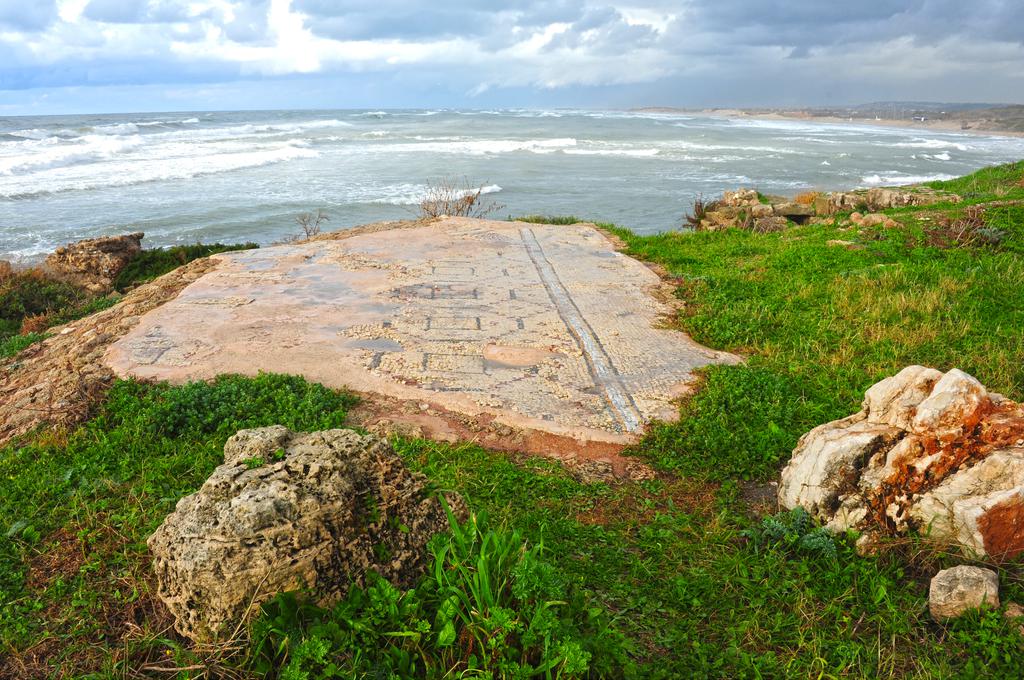
פסיספס בית הכנסת בקיסריה לפני השחזור והשיפוץ של הרשות לארכאלוגיה. צילום: גלעד פלאי
במובנים רבים קיסריה היא "הנמסיס" של ירושלים, כפי שכותבת הגמרא במסכת מגילה:
והדבר הזה היה ראשית המלחמה, בשנת שתים־עשרה לשלטון נירון, היא שנת שבע־עשרה למלוכת אגריפס, בחדש ארטמיסיוס (אִיָּר), אם גם סבת המלחמה לא יאתה לצרות הגדולות אשר יצאו ממנה, וזה הדבר: ליהודים היושבים בקיסריה היה בית־כנסת במקום אחד, אשר אדוניו היה יוני מקיסריה. והיהודים בקשו כל הימים לקנות את המקום להם לאחֻזה וגם אמרו לשלם כסף יתר מדי שויו, אולם היוני השיב את פני היהודים בבוז ולמען הרעימם החל להקים בחצרו בנינים חדשים ויסד שם בתי־חרֹשת והשאיר ליהודים משעול צר, אשר קשה היה לעבור בו. לראשונה התנפלו קצרי־הרוח אשר בקרב היהודים על עושי המלאכה, להשבית את העבודה. אולם פלורוס מנע אותם בחֹזק־יד מהמעשה הזה. ...פלורוס הבטיח אותם, כי ימלא את כל חפצם, אם יקבל את הכסף, אך כאשר הגיע הכסף לידיו עזב את קיסריה ויצא אל סבסטי והשאיר את בעלי הריב לעשות כטוב בעיניהם, כאלו מכר ליהודים בכסף את הרשות להלחם בשונאיהם ככל אות נפשם.
ה. ולמחרת היום, ביום השבת, כאשר נאספו כל היהודים בבית־הכנסת, יצא איש מחרחר ריב מקרב היונים יושבי קיסריה והפך סיר נפוח עם פיו למטה והציג אותו לפני מבוא בית־הכנסת וזבח עליו צפרים לקרבן. בדבר הזה חרף את היהודים מאד, כי חִלל את חֻקי תורתם וטִמא את המקום. נכבדי היהודים והמיֻשבים בדעת אמרו, כי עליהם לפנות בדבר המריבה הזאת אל הנציב. אולם רוח אוהבי־המחלקת ובני־הנעורים היתה כאש בוערת והם מהרו להלחם באויביהם. ...
מאות שנים אחרי המרד הגדול ברומאים עוד המשיכו לכנות את בית הכנסת בשם "כנישתא דמרדותא". לאחר שנים שבהם המקום הוזנח, הרשות לעתיקות והקרן לשימור קיסריה שיפצו את המקום, והיום זה ללא ספק אחד מבתי הכנסת עם הנוף היפה ביותר- מראהו של הים שממלא את כל האופק.
חשוב לציין במקום ניתן לראות את רצפת בית הכנסת, אבל יתר הממצאים (ובהם כתובת הקדשה, מנורת שבעת קנים ועוד) נמצאים במוזיאון עתיקות קיסריה שבקיבוץ שדות ים.
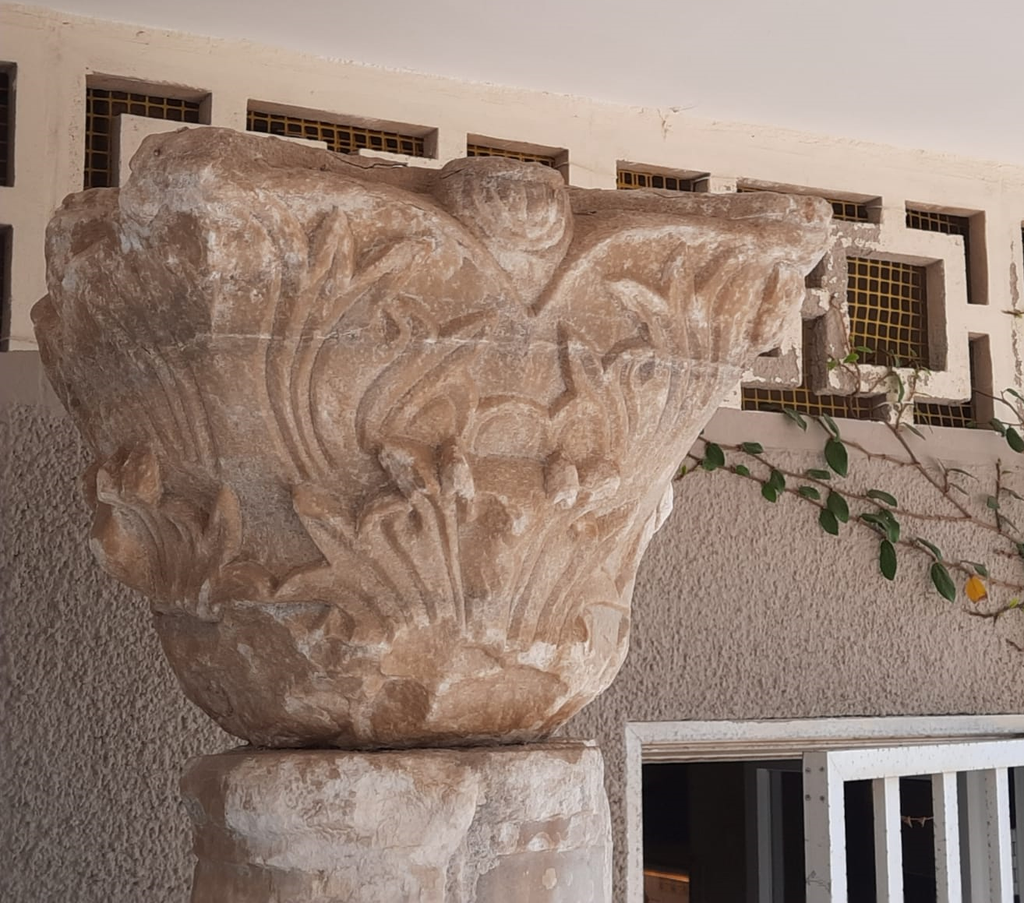
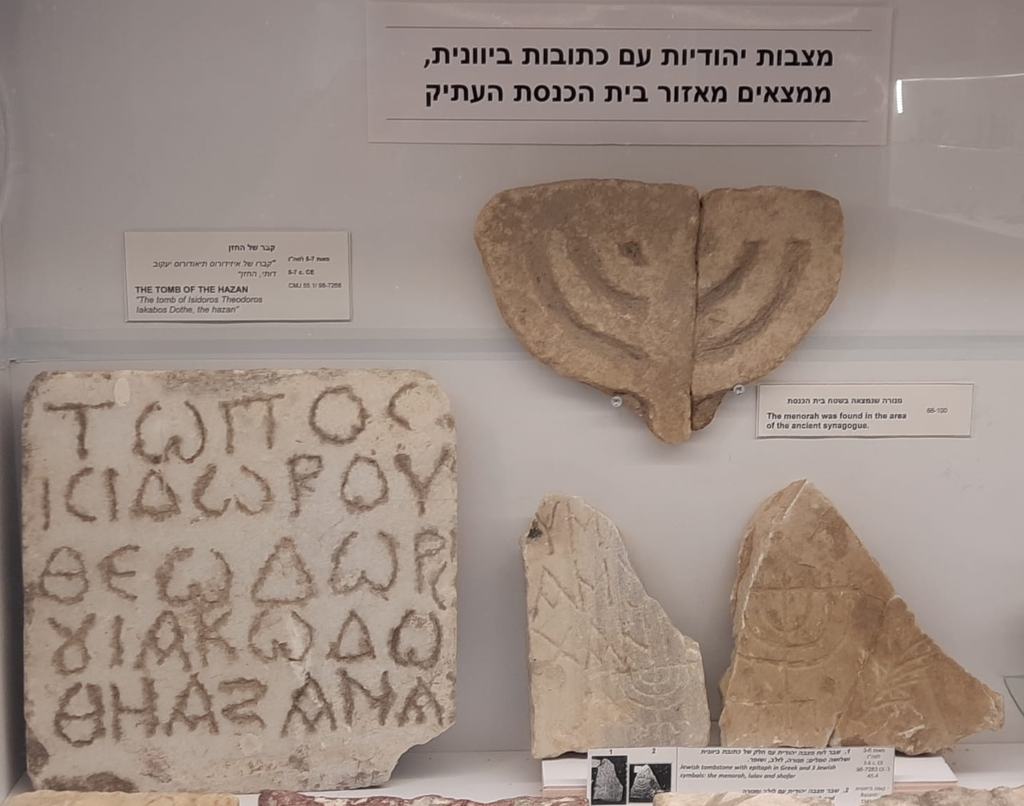
ממצאים של קיסריה היהדוית מתוך מוזאון שדות ים (שימו לב למנורה שחקוקה הראש העמוד). צילם: יאיר טיקטין
רבי אבהו היה אמורא ארץ ישראלי שחי בסוף המאה ה-3 , מתלמידיו החשובים של רבי יוחנן וריש לקיש. רבי אבהו כיהן בתור ראש ישיבה בקיסריה וייצג את היישוב היהודי בארץ בפני שלטונות האמיפריה הרומאית. הוא היה מפורסם ביופיו ובחוזקו וגם בכך שהוא דיבר יוונית על בוריה (ולימד את ילידיו לדבר ביוונית) . הוא ידע להגן על עמו ותורתו בכבוד וכישרון. בתלמוד ישנם מספר סיפורים על רבי אבהו שמתווכח עם הנוצרים (המינים) בני דורו . הסיפורים על רבי אבהו מתיישבים עם הממצא הארכאלוגי שמראה עד כמה קיסריה הייתה בתקופתו עיר מרכזית של השלטון הרומאי ועל גודלה של הקהילה הנוצרית בקיסריה. רבי אבהו ישב כדיין יחידי בקיסריה מה שמראה את חשיבותו בקרב הקהילה היהודית בעיר, הוא גם שימש כדיין בסיכסוכים של סוחרים יהודיים שהגיעו לנמל. מכוון שרבי אבהו שימש כדיין בעיר קוסמופוליטית, אנחנו מוצאים שבקיסריה קראו קריאת שמע בשפות שונות (ולא רק בעברית), על פי הגמרא רבי אבהו ישב "בכנישתא דמרדותא".
רבי אבהו מפורסם בכך שהוא זה שתיקן את סדר תקיעות השופר שנהוג עד ימנו בראש השנה- תשר"ת, תש"ת, תר"ת. רבי אבהו אהב מאוד את ארץ ישראל ועל אף הקשיים נשאר לגור בארץ, מפורסמת אמירתו ""אפילו שפחה כנענית שבארץ ישראל מובטח לה שהיא בת העולם הבא " אמירתו המפורסמת ביותר של רבי אבהו היא: אמר ר' אבהו: מקום שבעלי תשובה עומדים — צדיקים גמורים אינם עומדין," (ברכות ל"ד ע"ב)
לסיום ההרחבה אתם מוזמנים ללמוד סיפור קצר על רבי אבהו ורועה הזונות, סיפור מתוך התלמוד הירושלמי:
כשהייתה שנת בצורת נראה לרבי אבהו בחלום שעל מנת להיוושע עליו לבקש מאדם בשם פנטקקה (=שם אדם, שביוונית פירושו איש מושחת לגמרי) שיתפלל ובזכות תפילתו יירדו גשמים.
שלח רבי אבהו (=לקרוא לפנטקקה, כדי לחקור מי הוא) והביאו.
אמר לו: מה אומנותך? אמר לו: חמש עבירות אותו האיש (=כלומר: אני) עובר בכל יום: משכיר זונות, מקשט תיאטרון, ושוכר הטאירות (=מנגנות ורקדניות), ומביא בגדיהן לבית המרחץ ומטפח (=בידיים) ומרקד לפניהן ומקיש בצלצלים לפניהן.
אמר לו (=רבי אבהו): ומה טובה עשית?
אמר לו: פעם אחת היה אותו איש (=אני) מקשט תיאטרון ובאה אשה אחת ועמדה לה אחורי העמוד כשהיא בוכה. אמרתי לה: מה עסקך? אמרה: בעלה של אותה אשה (=בעלי) חבשוהו (=בבית הסוהר), והיא מבקשת לראות מה לעשות כדי להתירו (=מבית האסורים, ורמזה לו בכך שהיא רוצה להציע עצמה לזנות, כדי לאסוף כסף לשחררו). ומכרתי מיטתי והכילה שעל מיטתי ונתתי לה דמיהם, ואמרתי לה: הא לך והתירי (או: הא לך דמי התרת) בעלך, ולא תחטאי.
אמרתי לו (=רבי אבהו לפנטקקה): כדאי אתה שתתתפלל ותיענה
סיפורו של בית הכנסת כמו גם סיפוריו של רבי אבהו מייצגים סיפורים מורכבים של מיעוט יהודי שגר בתוך עיר שבה התרבות הכללית היא תרבות רומאית ושיש בה רוב נכרי. במאה הראשונה החיים המעורבים גרמו למרידה , ואילו במאה השלישית רבי אבהו ידע להתווכח עם המינים אבל גם ידע למצא את הטוב בתרבות השולטת ואף למצא את הטוב באנשים שבאו משולי החברה.
הסיור "בקיסריה היהודית" מעלה לנו אפשרויות שונות של יחס כלפי תרבות רומא. חשבו- האם אתם יותר מזדהים עם יהודי בית הכנסת שבחרו למרוד ברומא או דווקא עם רבי אבהו שבחר לפעול בתוך העיר שהיתה מזוהה יותר מכל כעיר רומית.
